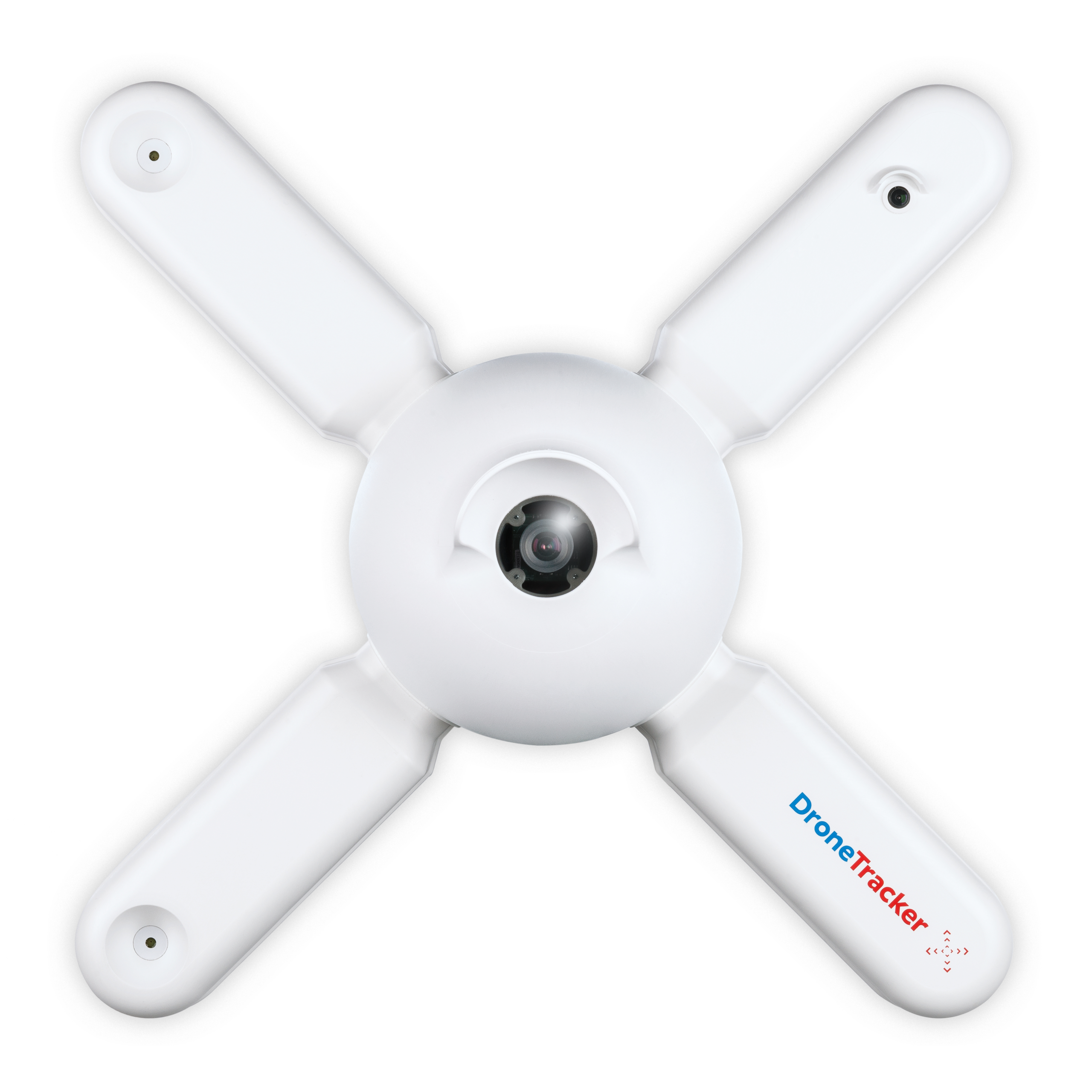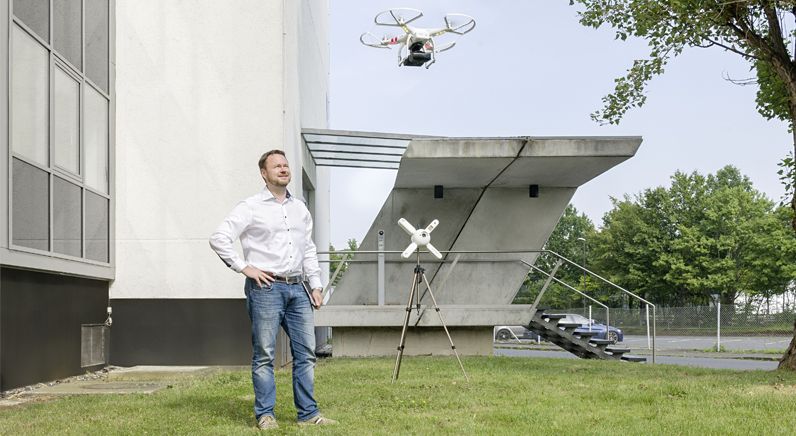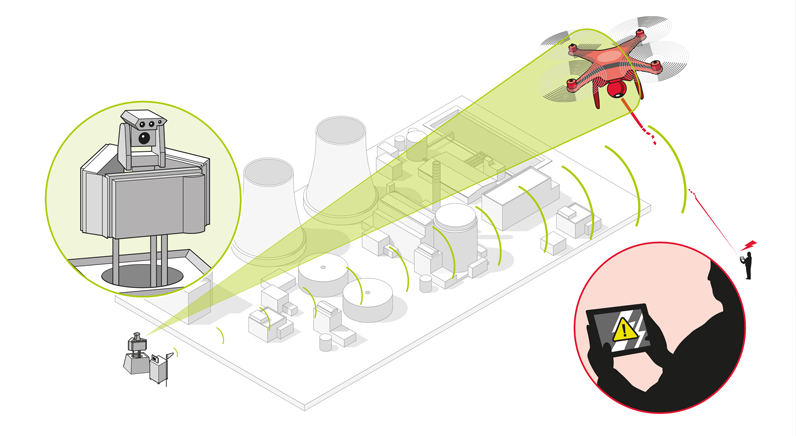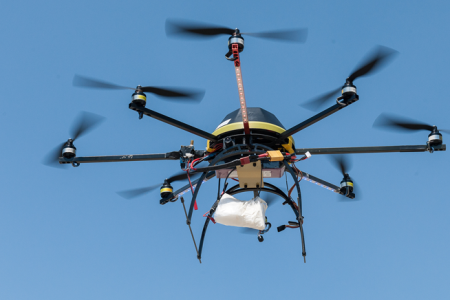Countering drones: a threat to security and safety
Tim Compston, Features Editor at SecurityNewsDesk, finds out what solutions are being developed to clip the wings of the soaring number of drones in our skies when they start to pose a threat to security, safety, or even engage in industrial espionage.
When deployed correctly drones or UAVs (Unmanned Aerial Vehicles) provide a powerful force multiplier for the military, government, law enforcement and those tasked with site security however, at the same time, this positive message has to be set against growing concerns over systems being flown recklessly or, more worryingly, with malicious intent by criminal or terrorist elements. The incident over the weekend, where a small drone is thought to have struck the front of a British Airways aircraft as it came into land at London’s Heathrow Airport serves to underline the dangers such devices can pose to air traffic, for example, if they are in the wrong place at the wrong time.

The right track
The DroneTracker from Dedrone, which was on show at Intersec 2016 in Dubai, is certainly one potential answer to this drone dilemma. Basically it is a multi-sensor drone warning system which, Dedrone reckons, reflects the reality that the size, speed, and shape of drones make identification extremely difficult for a single monitoring method. Utilising a system of interacting sensors the DroneTracker, is designed to reliably detect all types of drones based on multiple parameters such as noise, shape, and movement patterns, with the processing done in the device itself or via cloud computing. The DroneTracker’s built-in HD (High Definition) camera allows the saving of images and video so there is evidence of the intrusion.
Talking to Friederike Nielsen, Director of Marketing and Communications at Dedrone, she confirms that Dedrone was founded in 2014 with the specific aim of developing drone detection technology: “The DroneTracker is actually our first product to come to market. Launched last year it combines hardware and software. We aim to detect drones and then send off an alarm so that security guards can react immediately,” explains Nielsen. She stresses that when it comes to dealing with drones everything leads on from effective detection: “The first step must be detection because it is only when you know that a drone is approaching that you have a possibility of activating counter measures. You have to have a system which is able to detect drones 24/7, including at night, and gives you the information on the location, the speed, and the drone model.”

For his part, Jörg Lamprecht, Managing Director of Dedrone, spotlights industrial espionage as a growing area of concern where a solution like DroneTracker could, potentially, help organisations to better protect their intellectual property: “The issue of spying and utilising drones to secretly capture valuable content from entertainment companies, automobile testing facilities, or even corporations is becoming a considerable problem.”
Portable jamming
Another vendor exhibiting counter-UAV technology at the recent Intersec 2016 exhibition in Dubai was British company k9 electronics. The focus at Intersec was very much on the company’s portable drone jammers, confirms Managing Director, Glenn Darien, with the DJ700C long-range model designed to disable commercial and domestic drones from several kilometres away, and the DJ400P medium-range version at several hundred metres, by disrupting R/C control signals and GPS navigation.
“The current systems we offer are hand portable. You have to see the drone first because it [the jammer] is manually operated then you can take action to jam the drone so the operator loses control. Basically the system brings the drone down,” says Darien. Pressed on whether the action of jamming a drone means it will land automatically, Darien replies that what happens next depends, to all intents and purposes, on the type of drone being flown: “The cheaper ones just fall out of the sky whereas more expensive units tend to have a pre-programmed default to land safely if they lose GPS and lose control.” Regarding where he has found the most demand for jammers so far, Darien tells me there has been a real mixture of end-users: “There are the private individuals who are worried about drones spying over when they are in their private backyards and we also have airport and palaces out in the Middle East on our customer list.”
Expanding horizons
Turning to the next step for k9 electronics on the counter-UAV stakes, Darien reveals that the business is expanding its horizons even further with the imminent launch of a solution to automatically identify the presence of a drone and then to track and jam it. Darien is scheduled to fly to the US, shortly, to fine-tune some of the details of what he refers to as the ‘Detect, Classify, Track, and Jam’ solution: “It is more or less ready at the moment and should be launched at the end of next month (March). We are developing it [Detect, Classify, Track and Jam] with a company in the States.” Although full details of the solution are still under wraps, Darien was willing to sketch out a few of the elements: “This solution is for fixed site installations where they want a constant system to monitor the perimeter. It uses microwave radar to actually do the detection and then for the tracking it is using video analytics to do the classification.”
An Airbus answer
Airbus Defence and Space (Airbus DS) – a division of Airbus Group – has also unveiled its own response to the heightened threat posed by small drones in the shape of a Counter-UAV System. This, says Airbus DS, has been designed to detect ‘illicit intrusions’ of Unmanned Aerial Vehicles (UAVs) over critical areas at long ranges backed-up by electronic countermeasures ‘to minimise the risk of collateral damage.’ Speaking when the company’s Counter-UAV System was first announced back in September, Thomas Müller, Head of the Electronics business line at Airbus Defence and Space (Airbus DS) started out by painting a picture of the existing threat landscape to explain the rationale for such as solution: “All over the world incidents with universally available small drones have revealed a security gap with regards to critical installations such as military barracks, airports or nuclear plants.”

Drilling down into the specifics of how the Counter-UAV System operates, according to Airbus DS, it combines sensor data from different sources with the latest data fusion, signal analysis, and jamming technologies. Essentially the system uses operational radars, infrared cameras, and direction finders from Airbus Defence and Space’s portfolio to identify the drone and assess its threat potential, as well as to find the pilot, at ranges between 5 and 10 kilometres. In addition, based on an extensive threat library, and real-time analysis of control signals, a jammer is able to interrupt the link between drone and pilot and/or its navigation.
Five months on from the initial launch of the Counter-UAV System, and Meinrad Edel, Director of Sales – Protection and Reconnaissance – at Airbus DS Electronics and Border Security, recently gave me an update on how things are progressing, crucially, Edel was able to confirm that the system is now available for purchase and, anticipates the first customer deliveries happening from Q4 this year.
Defence system solution
Another take on combating drones, which has certainly garnered many headlines and column inches since it was officially announced last May by a trio of British companies who pooled their expertise for the project – Blighter Surveillance Systems, Chess Dynamics and Enterprise Control Systems – is the appropriately named Anti-UAV Defence System (AUDS). At the time it was promoted as being the ‘world’s first fully integrated detect-track-disrupt’ system for defence against UAVs.
Graham Beall, Managing Director, Chess Dynamics argues that countering drones is now very much a global issue and an increasing concern for the military, government, and homeland security forces across every continent: “Our system has been developed to address this urgent operational requirement and has been successful in government sponsored counter-UAV trials, detecting and disrupting a variety of fixed and rotary wing drones in under 15 seconds.”

When up and running, the revolutionary Anti-UAV Defence System (AUDS) integrates the Blighter A400 Series Ku band electronic scanning air security radar, Chess Dynamics’ stabilised electro-optic director, infrared and daylight cameras and target tracking software, and a directional radio frequency (RF) inhibitor from Enterprise Control Systems to detect, track, classify, disrupt and neutralise UAVs at ranges of up to 8km. Apparently, the AUDS system is even effective against Group 1 micro UAVs at ranges of up to 2km and Group 1 mini UAVs at ranges of several kms.
Market expansion
With the number of drones taking to the skies showing no sign of slowing down any time soon it is perhaps not surprising – given the associated security issues – that the market for anti-drone solutions is very much on the up too. It will certainly be interesting to see what traction the competing technology-based systems spotlighted gain in the months and years ahead.
[su_button url=”https://www.securitynewsdesk.com/newspaper/” target=”blank” style=”flat” background=”#df2027″ color=”#ffffff” size=”10″ radius=”0″ icon=”icon: arrow-circle-right”]For more stories like this read the SecurityNewsDesk Newspaper[/su_button]
Header image: Dedrone – drone smuggling drugs © Jens Distelberg











